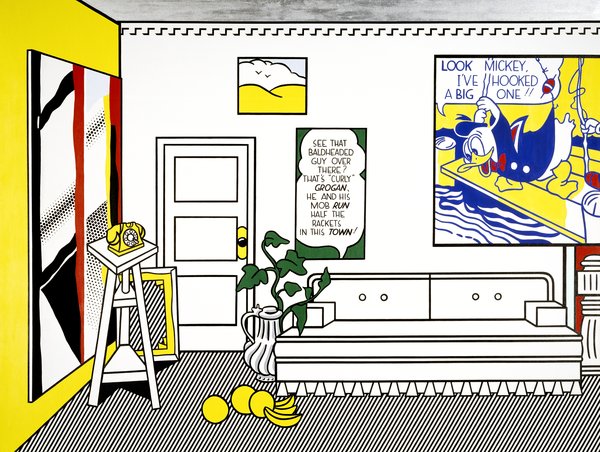Facts About Artist's Studio Look Mickey
"Artist's Studio—Look Mickey" is a captivating painting created in 1973 by Roy Lichtenstein. This work is part of a series of five large-scale studio interior paintings where Lichtenstein draws inspiration from Henri Matisse's oeuvre, particularly "L'Atelier Rouge." The piece pays homage to Matisse's opulent, harmonious interiors and his renowned composition "The Dance."
In "Artist's Studio—Look Mickey" Lichtenstein cleverly incorporates elements from his previous works, specifically "Look Mickey." Unlike traditional artist studios cluttered with tools and canvases, Lichtenstein's studio scenes resemble stylish interiors adorned with his earlier creations. This painting features recognizable items such as a mirror, a telephone, and a bowl of fruit, all sourced from his earlier pieces, with "Look Mickey" prominently displayed.
Lichtenstein’s decision to meticulously replicate his own works within this new context was unconventional. His aim was to eliminate variations and produce a cohesive, unified composition. This approach was influenced by masters like Matisse and Fernand Léger, with particular nods to Matisse's "The Red Studio."
By embedding Matisse's distinctive style into his own studio setting, Lichtenstein positions himself as a modern-day counterpart to Matisse, suggesting that pop art belongs in the continuum of art history. The painting is sprinkled with subtle references and playful elements, such as the static portrayal of the telephone from Lichtenstein's "R-R-R-R-Ring!!"
Critics have observed that the Studio series possesses a reflective, almost retrospective quality. It functions like a mental playground where viewers can explore the artist's life and work. Interestingly, the way Mickey Mouse is cropped out in "Artist's Studio—Look Mickey" shifts the focus to Donald Duck, which some analysts interpret as a deeper metaphor.
Lichtenstein's innovative method of incorporating his own artworks into new compositions makes the Studio series a fascinating blend of modernism and postmodernism. It is a brilliant showcase of how an artist can honor the past while creating something entirely fresh and engaging.

 Mexico
Mexico